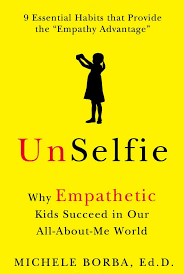
Unselfie: Why Empathetic Kids Succeed in Our All-About-Me World
By: Michelle Borba, Ed.D.
Book Report by Amber Hausman
Reading this book made me realize how relevant La Vida is to this generation of young people. We give students an opportunity to make face-to-face connections and develop deep, meaningful friendships.
The book takes us through the following structure to help us understand empathy and its importance in our lives:
Developing the fundamentals of empathy:
- Emotional Literacy
- Moral Identity
- Perspective Taking
- Moral Imagination
Practice habits of empathy:
- Self-regulation
- Practicing kindness
- Collaboration
Ways to live empathetically:
- Moral courage
- Altruistic leadership abilities
Michelle Borba coins the term Selfie-Syndrome which is “Me” centered. It’s a self-absorbed condition that is all about self-promotion, personal branding, and self-interest at the exclusion of others’ feelings, needs, and concerns.
Narcissism is on the rise in the Western world. Kids who feel entitled focus on their needs and feelings, direct their perspective on their experiences and see the world through their eyes. Left out of their picture is anyone else, and there go the opportunities to learn to value others.
Empathy on the opposite spectrum is “Others” centered. It is being able to identify with or vicariously experience the feelings, thoughts, or attitudes of another. The foundation for empathy is face-to-face human connection.
- We are born with the ability to empathize but it is a characteristic that must be nurtured. It can be developed.
- At the base of any empathetic moment is human connection. In today’s hyper-individualistic, plugged-in culture, we need to find ways to create friendlier, caring cultures to help our children see with the eyes of another, listen with the ears of another, and feel with the heart of another.
We must get our kids to switch their focus from “I, Me, My, Mine” to “We, Us, Our, Ours”.
Concerns:
- Teens are now 40 percent lower in empathy levels than three decades ago, and in the same period, narcissism has increased 58 percent.
- “I want to be famous” article in Britain shows that the current top 3 career choices for 8-11 year olds is pop star, movie star, or sports star compared to 20 years ago- teacher, finance, medicine.
- As empathy levels decrease, peer cruelty increases. 1 in 5 middle school students contemplate suicide as a solution.
- Experts observe more cheating and weaker moral reasoning in young people: 70 percent of college students admit to cheating.
- Our plugged-in, high-pressure culture is leading to a mental health epidemic among young people. 1 in 5 US youth meets the criteria for a mental disorder in their lifetime. Teen stress levels are higher than adults. As anxiety increases, empathy decreases- hard to feel for others when you’re in survival mode.
- The average 8-18 year old is plugged in to a digital media device about 7 hours and 38 minutes a day (NOT including texting or talking on a phone)
- 75% of children 8 and younger have access to a smart mobile device at home.
- Preschoolers spend 4.6 hours/day using screen media
- 40% of 2-4 year olds us a smartphone, MP3 player or tablet.
- 30% of children first play with mobile devices when they’re in diapers.
- Between school, sleep, extracurricular activities and screen time, there is limited opportunity for REAL face-to-face interactions
- 62% of school-age kids said that their parents are too distracted when they try to talk to them. The top distraction is cell phones.
- Study on home sounds found that television reduced parent-kid interaction. For each hour of audible background television, 500-1,000 fewer adult words were spoken and heard by their kids.
Suggestions/Teaching Techniques That Apply to La Vida:
- Set unplugged times with staff and participants. Identify sacred “family” times and places and set clear media limits. Ex: main lounge at BC is tech-free zone.
- Kids need face-to-face time to learn to read emotions and develop human connections. We provide that sense of community in our programs, ie life stories, group games/initiatives, debriefing.
- Jig Saw Puzzle Learning: Originally created out of necessity to defuse racial issues in Austin, TX. Intended to make each student feel a necessary part of the community as well as for other students to view them as such. In a group of 5-6, an activity is broken down into that many parts. Each person is responsible for learning that part and teaching to others. If you have multiple groups, the “experts” of each topic also connect with the “experts” in the other groups before coming back to their group to teach it.
- Read literary fiction and try to see through the perspective of each character
- Watch movies and have a discussion about character, morals etc.
- While watching movie or reading pause and ask: How would you feel if….? What would you do in that situation?
- Kindness board: could maybe incorporate at the ropes course for a full day group. Each time someone receives a kind gesture they write a thank you to that person and post it on the board.
- Create a family motto/set of values: we do this with the covenant. Important to always go back to and reevaluate if we are doing what we say.
- Conflict Resolution:
- When there is conflict between two people and they can’t make a decision about how to move forward have them use rock, paper, scissors. This seems to apply to younger kids (sharing toys, what game to play etc) but could be useful for team-building activities.
- Each person (in conflict) needs to tell what happened from another person’s perspective.
- Use finger puppets to tell the story/how you feel

Enlightening! Thanks for the review. I’m purchasing the book today.